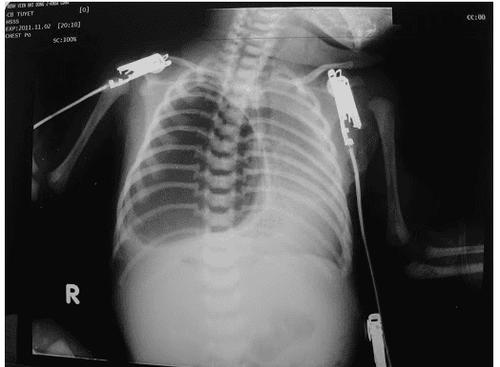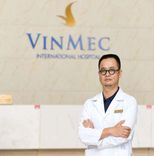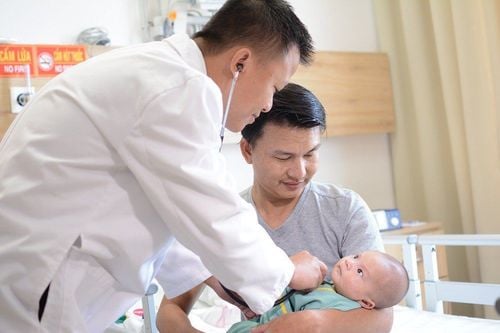This is an automatically translated article.
The article was professionally consulted with Specialist Doctor I Nguyen Dinh Hung - Radiologist - Department of Diagnostic Imaging - Vinmec Hai Phong International General Hospital.And Specialist I Vo Cong Hien - Doctor of Radiology - Department of Diagnostic Imaging - Vinmec Nha Trang International General Hospital.
A cystic lung lesion is defined as a low-density, air-filled cavity in the lung parenchyma, usually with a thin wall. Pulmonary cysts can be congenital or acquired.
Congenital pneumothorax, which develops during the fetal period, includes many different pathological groups: congenital cystic abnormalities, congenital lobar emphysema, pleuroblastoma, cysts of pneumothorax tracheobronchial, isolated lung,... In contrast, acquired pneumococcal cyst occurs secondary to primary lung diseases such as lung abscess, traumatic lung tear, and infection with cyst formation (canine fluke infection). , lung fungus,..), pneumothorax with air cysts,... Pulmonary cysts are detected by X-ray with air bubbles on tomography and can be treated with surgical method.
1. What is a lung cyst?
Pulmonary cyst is a congenital malformation of the lungs, abnormal cysts in the lungs, which form and develop during the fetal stage. This is a rare malformation, many small cysts develop from a part of the lung but no lung parenchyma. These cysts have a simple structure of a thin shell that encloses the air cocoon inside. Although developing in the lungs, these cysts cannot perform the normal respiratory function, thus, causing respiratory failure complications.Up to now, the cause of cystic lung malformation has not been clearly defined. Genetic factors were also not shown to be involved.

Kén khí phổi gây suy hô hấp cho ngưởi bệnh
Trắc nghiệm: Làm thế nào để có một lá phổi khỏe mạnh?
Để nhận biết phổi của bạn có thật sự khỏe mạnh hay không và làm cách nào để có một lá phổi khỏe mạnh, bạn có thể thực hiện bài trắc nghiệm sau đây.2. Diagnosis of pneumothorax
Pulmonary cysts usually do not cause any symptoms. In young children, the disease can cause symptoms of respiratory failure after birth, leading to a high mortality rate. However, this malformation can be detected by ultrasound during pregnancy. Therefore, regular antenatal check-ups are very important, which can help detect birth defects in the baby's lungs early.
If not detected in the fetal stage (due to the absence of symptoms), pneumothorax develops and is detected through physical examinations, or when the disease causes respiratory complications such as cough bleeding , infection , ruptured air cyst causing pneumothorax .
Pulmonary cysts are diagnosed by X-ray method. The chest X-ray image of a pneumothorax is a bright, round or oval bubble with a thin line of contrast surrounding it. Air cysts range in size from 2 - 3 cm to several tens of cm, usually appearing on one side of the lung, under the pleura.
However, it is important to distinguish pneumothorax from other lung conditions such as pneumothorax, tuberculosis, bronchiectasis, or lung abscess. These cases need bronchoscopy or tomography to confirm. Therefore, it is necessary to conduct computed tomography to make an accurate diagnosis.

Kén khí phổi trên Xquang
3. Treatment of pneumothorax
Although rare, pneumococcal cysts can be treated if detected early and yield positive results. Depending on the medical condition, the doctor will appoint the appropriate treatment method such as:If the diagnosis of large air cyst, the patient is accompanied by complications such as hemoptysis, or recurrence, surgery will be indicated. remove the air cocoon. If the cyst causes an infection, the patient is prescribed an appropriate antibiotic. Pulmonary cysts can be detected by X-rays. The disease can be treated with surgery or antibiotics to limit recurrence and complications.
X-ray diagnosis of pneumothorax gives accurate results about the condition of the disease, so that doctors will give the most accurate treatment plan for the patient, minimizing complications of the disease.
Currently, Vinmec International General Hospital with the motto: Always put the patient at the center, Vinmec is committed to bringing comprehensive and high-quality healthcare services to customers.
The general hospital uses the new generation of mobile and fixed digital X-ray techniques of the world's leading medical equipment manufacturers such as: GE, Toshiba.... as well as current techniques other tools to diagnose and treat lung diseases.
With modern facilities of international standards, quality medical services, a team of medical professionals, experienced doctors will bring optimal treatment results to customers.
Friendly hospital environment, international standard pre-, post-operative care facilities will bring the most accurate diagnosis results, best treatment, fastest health recovery.














